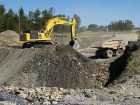
Features
Aggregates
Aggregates in a Slump
Is the aggregate business on the rocks in New Brunswick?
June 10, 2015 By Carroll McCormick
On the face of it, New Brunswick’s 2015-16 transportation and infrastructure budget, at $409.5 million, is surely a cheery improvement over last year’s $213.2 million budget. But for aggregate producers, there is little in it to crow about, according to Tom McGinn, executive director of New Brunswick Road Builders & Heavy Construction Association (RBHCA).
“This year the majority of the Department of Transportation budget is paving. It represents over 90 per cent of the program. We can’t wipe the smiles off the faces of our paving guys, but it is just mill and pave,” McGinn says. The tendered work in the 2015-16 budget is worth $200 million and, McGinn notes, “These tenders include paving, structures, grading and chip sealing, so work that requires aggregates is just a subset of these values.”
According to the New Brunswick government, there are three new road construction projects in this year’s budget: $19.2M to begin twinning Route 11 from Route 15 to the Shediac River, $20 million for continued work on the Route 11 Caraquet Bypass and $5.4 million to complete upgrades to Route 17 in the Black Book area near St. Quentin.
In 2012 the RBHCA did a survey, looking back at 2010 over the course of a construction season. “The workforce was down 1,500-2,000 people. We had a couple of companies go from 200 down to 50 people. At its peak, the industry had 7,000 people. It’s basically a lack of road building, not road repairs,” McGinn says.
McGinn recites the tendered work in the previous five years: 2014/15: $87M; 2013/14: $91M; 2012/13: $82M; 2011/12: $60M; 2010/11: $155M. “Government spending has not been what it was. We are even seeing [a decline in spending] with private investments,” he adds.
Depending on who is doing the talking, the last heyday for road builders and aggregate producers in the province was 2010 and the twinning of Route 1 from Saint John to St-Stephens at the U.S. border, completed in 2012 at a cost of $540 million. However, says one insider, who prefers to remain nameless, “An out-of-province company [Dexter Construction] won that contract. The local guys were looking in. This kind of killed the highway program for the next few years. It sucked the money out of the highway program.”
Despite the Route 1 work, the aggregate industry appears to have been on the skids even before 2010, judging from that RBHCA survey. McGinn figures that the bust came after the last road-building spree between 2006 and 2009, on the heels of the twinning of Route 2, New Brunswick’s portion of the Trans Canada, which was mostly completed in 2007.
“The Trans Canada was great for everybody. In that stretch of highway there was a group of companies that got together and bid in that project. It was great,” McGinn says. “Also, at the time, other work was done in the province, so the smaller contractors were not worried that the bigger contractors would come in and gobble up the contracts. That was a good time to be a road builder. The Tory government came in in 2010 and everything fell off after that. Guys hung onto equipment for a few years but last year we had a few who sold off their equipment. I would say it has been on the decline, basically, since 2010.”
Jamie Bird is the project manager for Valley Aggregates in Burtts Corner. His assessment of the situation is blunt: “The aggregates business has been in the shitter since the last big highway project – Route 1. There’s not a lot that goes on in New Brunswick, compared to other provinces. We stay in business because we sell concrete sand across the border to the US. Sixty to 70 per cent of what we do is across the border. We also sell sand and rock to Fredericton. We don’t rely on New Brunswick. It is all revolving around the New Brunswick financial position. It’s bad. There is nothing in New Brunswick. No-one is getting into it new right now.”
Jamie’s father, Terry Bird, has seen other aggregate producers go out of business. One, A. Albert, in Rexton, closed two years ago. It had 100 employees. Another, Clarence Daigle, in Edmunston, was bought out by Northern Construction about five years ago. “They were a pretty big outfit,” Terry says.
As for the good times, Terry is of two minds. “I don’t remember any heyday,” he says. Then, he adds, thinking back to the years when the intersection of fuel and aggregate prices was above water, “There was a heyday in New Brunswick, but in terms of pricing, we are way behind. The pricing is off by 20-30 per cent. “Back in 1980, when diesel was 30 cents a litre, we were getting $4/tonne to haul gravel to Fredericton. People are hauling it now for $3.50/tonne. The government rate is about $6/tonne. Diesel is $1.20/litre now. I have no idea why people want to do that. The big problem with the aggregate industry is that everyone is selling it for nothing. We haul screened sand across the border at $3.50/tonne, but the place we take it to sells gravel right out of the bank for $5.”
Back in the day, Valley Aggregates kept 14–15 people employed for years. Now the company has just two employees. Three years ago Terry sold his company, loaders and dump trailers, but kept his crushing plant and the lease on three pits. “I wanted to concentrate more on building conveyors and screening plants. We buy and sell a lot of aggregate equipment,” Terry says.
“We build conveyors for $15-25,000, and aggregate equipment. This is what the small operators use,” Jamie says. “We are not relying on big projects to keep us going.”
Terry is terminally puzzled about the compulsion to wring the cheapest deal possible out of haulers, and what that is doing to the business. “Before I sold out, I was selling drain tile rock for $6.50/tonne, a normal price around here. At the same time guys in Aylesford and Bridgewater [in Nova Scotia] were getting $15/tonne. The guys on the other side of the border were getting $14.
“Here, a company will give a $10,000 price. Another guy will do it for $3,000. It’s not just aggregates. It’s everything. I bid on a job, we figured it would be $200,000. A guy came in from PEI and did it for $46,000. He got halfway through the job and they kicked him off the site. To even let a contract go for that little money … it was a government contract. I can’t believe it is as cheap as it is. It may never change.”
To proclaim that there are too many aggregate haulers may be more truism than brilliant deduction, since there is not enough business for everyone, but the problem goes deeper than that, Terry says. It’s also attitude. “That is part of it, but maybe they want the last job, to get it from someone else. I’ve heard it a lot that companies will keep someone on just to keep them from going to another company.”
While insisting that he doesn’t “have any direct insight into anything,” Allan Higgins, general manager of Brookville Manufacturing Company in Saint John, puts a cautious oar in. “There are no big projects. It is so flat. We are not directly involved in the big projects, but we can be busy busy. The last few years have been really slow for everybody. We are getting a good share of what’s going on – small and medium contractors support the local projects – but the big action is in the single projects.”
The next source of major aggregate action in the province could be the Energy East Pipeline to Saint John. This project is by no means a fait accompli. However, Higgins speculates, “I feel everyone in this area will be involved to some extent if the pipeline is built. Resources is the only thing going.
Print this page

